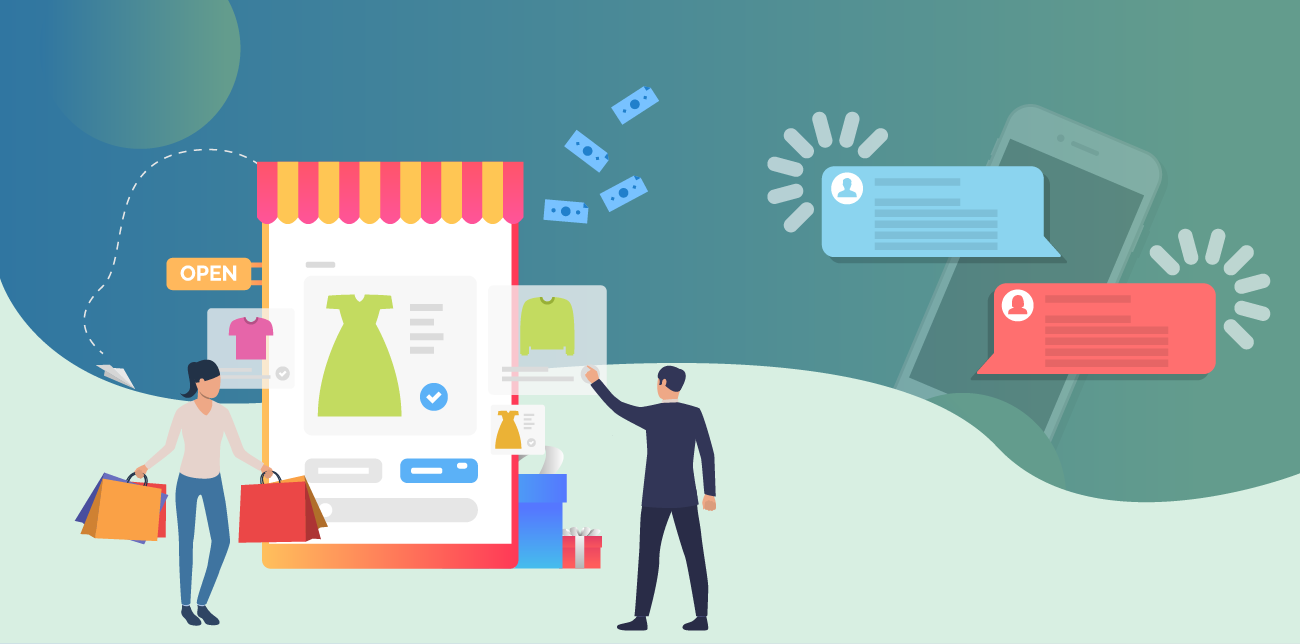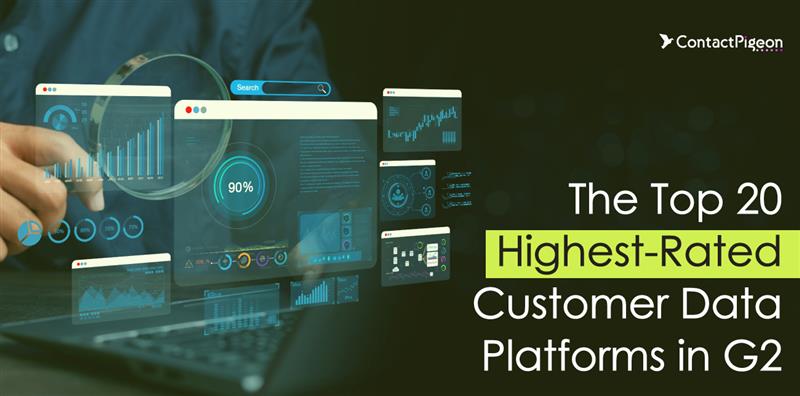Fashion is one of the industries that has seen constant economic success over the past decade. In 2018 alone, the global online fashion market has brought in $484 billion, representing 27% of total fashion retail sales occurred online.
While the fashion industry enjoys great profitability, the margins are facing pressures from new entrants and competitive landscape. Considering that the global fashion market online is predicted to reach $765 billion by the year 2022 (a 58% increase from today) every marketer needs to have the latest tools and strategies to boost their fashion eCommerce marketing.
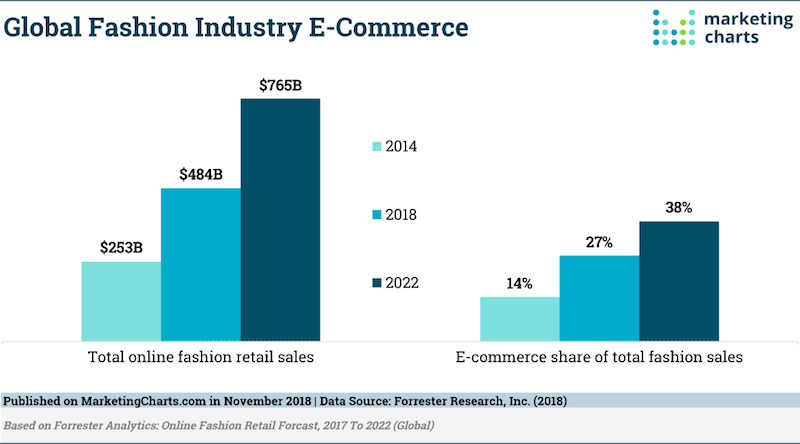
Source: Marketing Charts, Fashion eCommerce marketing chart
Savvy marketers understand that marketing automation is no longer a trend, but a necessity within a brand’s marketing capability.
In this post, we collected 5 automation flows for eCommerce fashion brands to help you stand out from the competition.
Here are the things that we will discuss in this article:
How can marketing automation help your fashion brand?
Email marketing automation is simply NOT ENOUGH in 2019. Brands need to engage with consumers like never before with personalized marketing. You can sell more, present relevant and valuable information to your customers by using the latest automation tools available for eCommerce shops.
Don’t take it from us. Take Zara for example. Zara dominates the eCommerce industry by building behavioral-triggered omnichannel marketing automation campaigns via email, SMS, and on-site messages throughout their site. All of this can only be done with marketing automation. It’s the only way to create channel-agnostic and truly personalized touchpoints with customers.
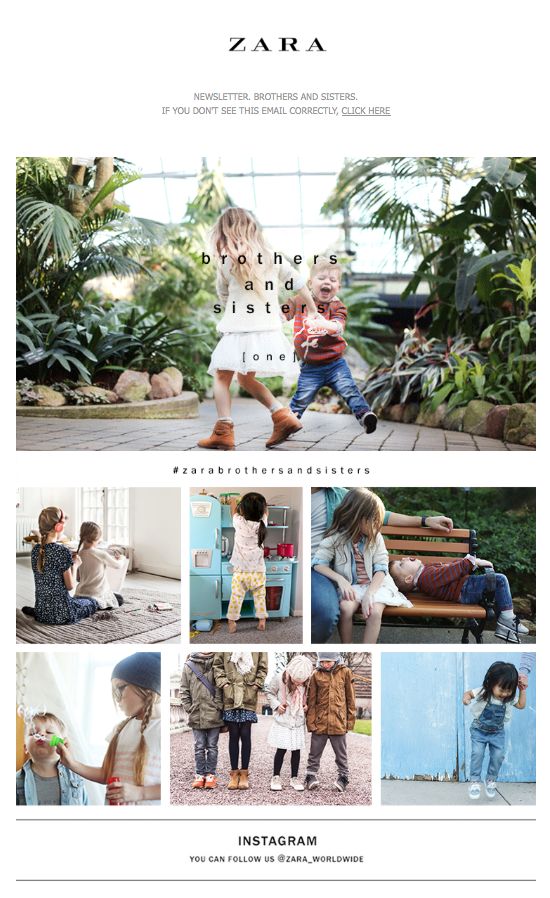
An example of Zara’s newsletters and Fashion eCommerce marketing
There are numerous benefits of adopting marketing automation into your eCommerce strategy. A sophisticated marketing automation tool can help you::
- Increase sales
- Improve customer experience (with personalized offers, content, suggestions, etc.)
- Save time
- Gather insights on visitor/customer behaviors
- Benefits across all customer funnels (nurturing new leads, retention, repeated sales, and loyalty)
- Gain ROI
Now, let’s check out the top fashion eCommerce marketing automation flows to boost your online brand.
5 fashion eCommerce marketing automation flows that work
Fashion automation #1: Create a Welcome email flow to nurture your email list
Building a Welcome email series is vital for eCommerce fashion marketing automation flow since 98% of your site’s visitors are not ready to buy when they first visit your online shop.
Once a visitor signs up, Welcome series is a great way to nurture visitors and build relationships, while also learning more about your customers. You can use the opportunity to share topics that are vital to your brand’s mission or get the recipient to move forward with a specific call to action.
A great example of a Welcome email is one from Bellroy, am Australian accessories brand. The email strikes a friendly and welcoming tone to any new joiners and does a great job in presenting what the brand is all about in an engaging way, using coherent design.
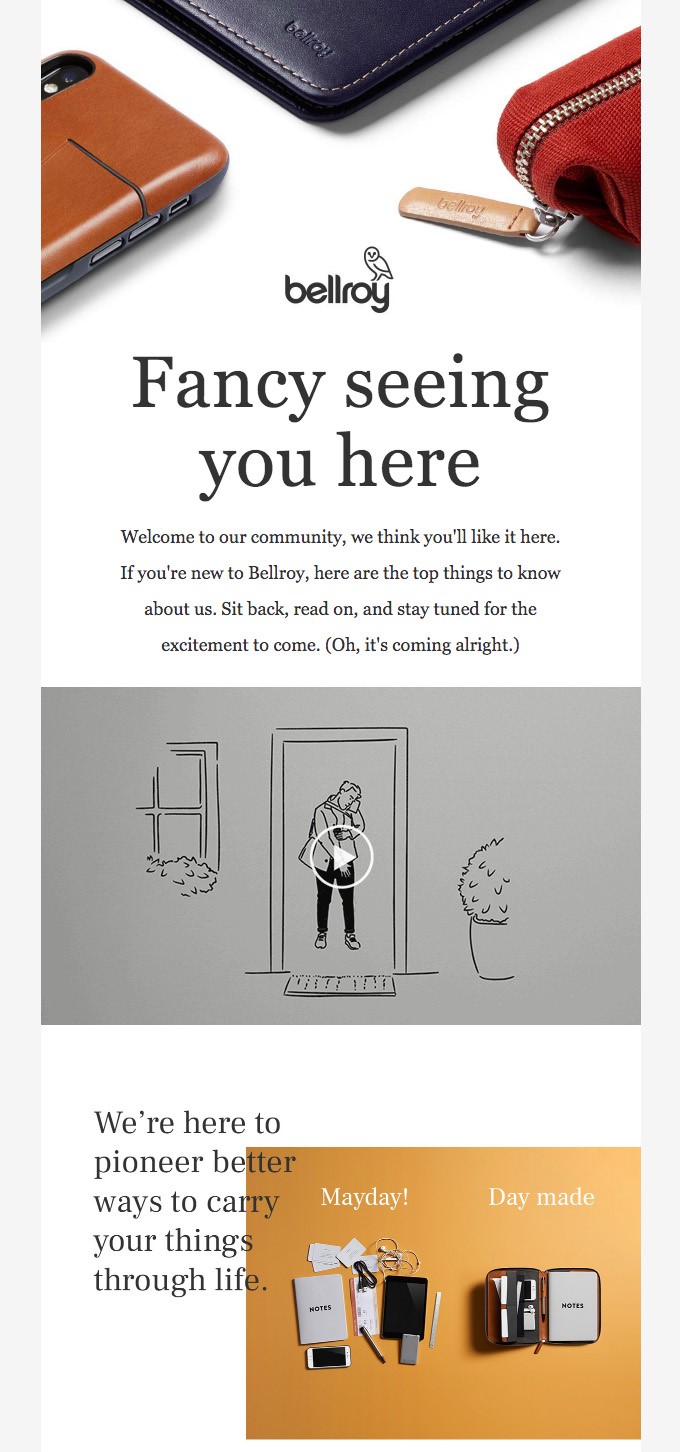
Welcome email from Bellroy.
Within the welcome note, Bellroy takes the chance to showcase the content that subscribers can expect, creating a sense of anticipation.
Lastly, it showcases the most popular products from the brand with a distinction between men, women, and other categories. This is a great starting point for the marketer to start capturing consumer interests. Depending on the product category email recipient click into, the data points from email engagements can generate insights for targeted offers down the line.
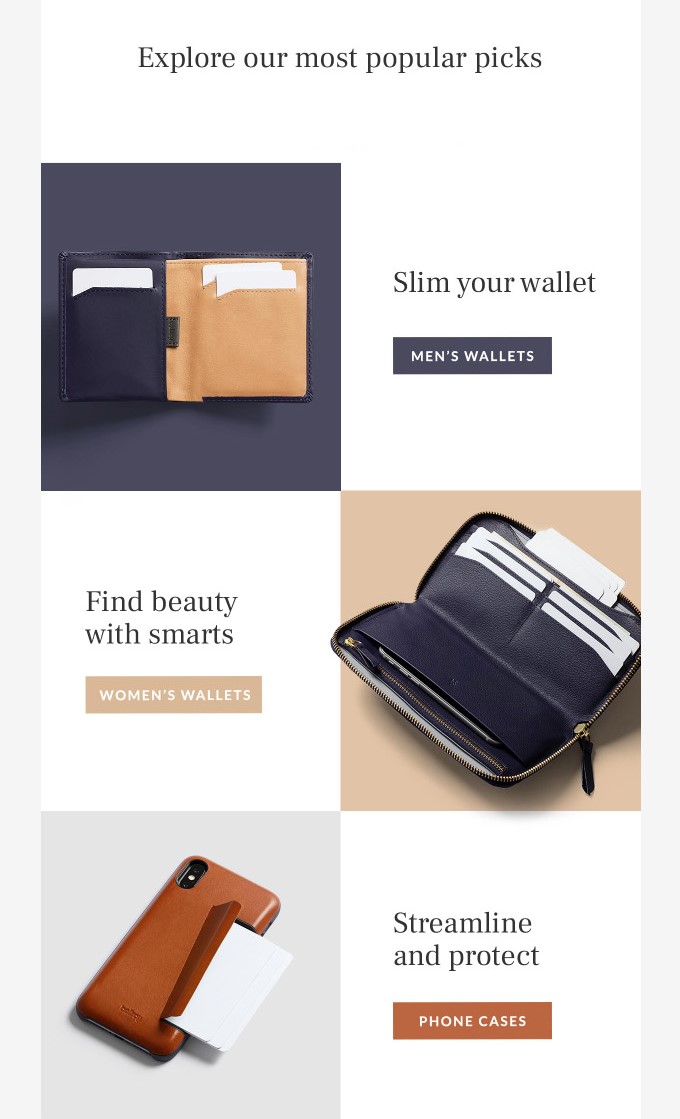
Bellroy includes the most popular product categories within its welcome newsletter.
Suggested Welcome Series Set up
The nurturing series should go well beyond one single welcome newsletter. We suggest planning a sequence that spans 4 to 6 weeks.
Starting with a “Welcome” note within 15 minutes after signup or account creation. Followed by a few more touchpoints every week. The content for the welcome nurturing series can vary widely from brand to brand. You can use each communication to feature the mission your brand is passionate about or highlight a unique selling point of your products. In Bellroy’s case, the focus is on their product design and durability.
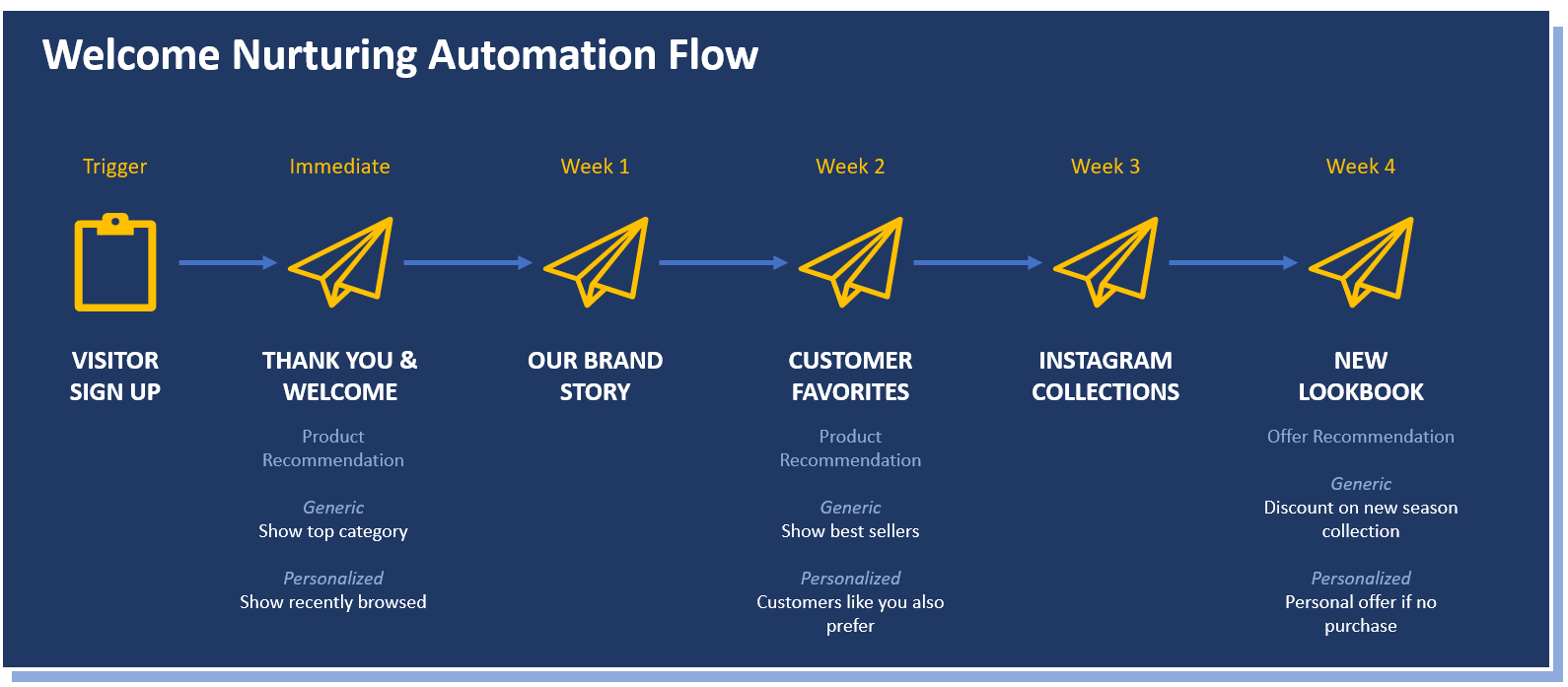
Welcome automation flow
If your business keeps a blog, consider sharing favorite blog posts to hook readers’ attention with interesting and valuable information. In each of your email, try also to include relevant offers targeted to customer interest every other email, and so on.

Fashion automation #2: Create a Price Drop Reminder to increase Customer Retention
In the online fashion industry, the competition is constantly offering up discounts and special deals. This is why you need to have a dynamic and personalized tool that will automatically contact your customers about relevant savings, such as price drops of items they have previously viewed. This tactic can greatly improve customer loyalty and retention as well as boost conversions resulting in more sales.
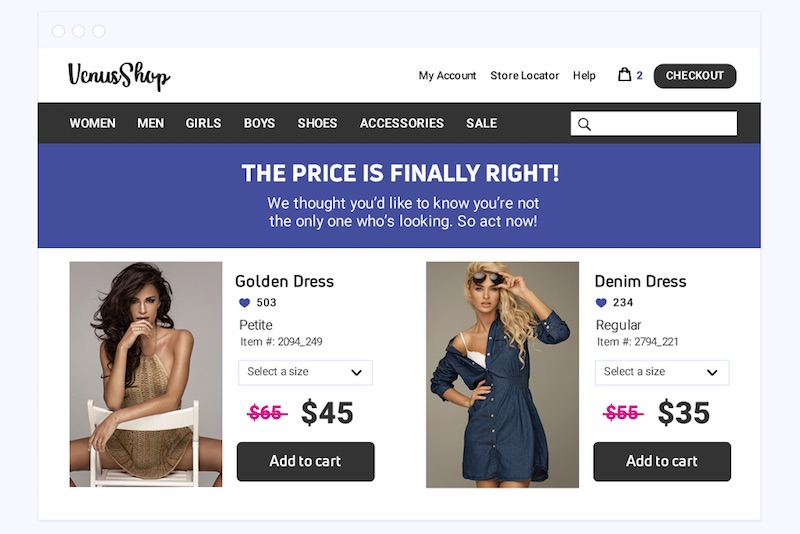
Fashion eCommerce marketing example of price drop notification.
Suggested Set up: The best way to use Price Drop alerts is to combine it with Abandoned Browse automation flow. The flow is triggered once the price of a certain product has decreased by a set threshold (say 5% or more). The recipients of the price drop alerts should be the visitors who have browsed the item but have not purchased it. The message, which can be sent via email or push notification, should remind the recipient of the item they are interested in and the newly lowered price. For the most effective price drop, you can limit the recipients to those who have recently viewed the product multiple times, as a stronger indication of interest and recency.
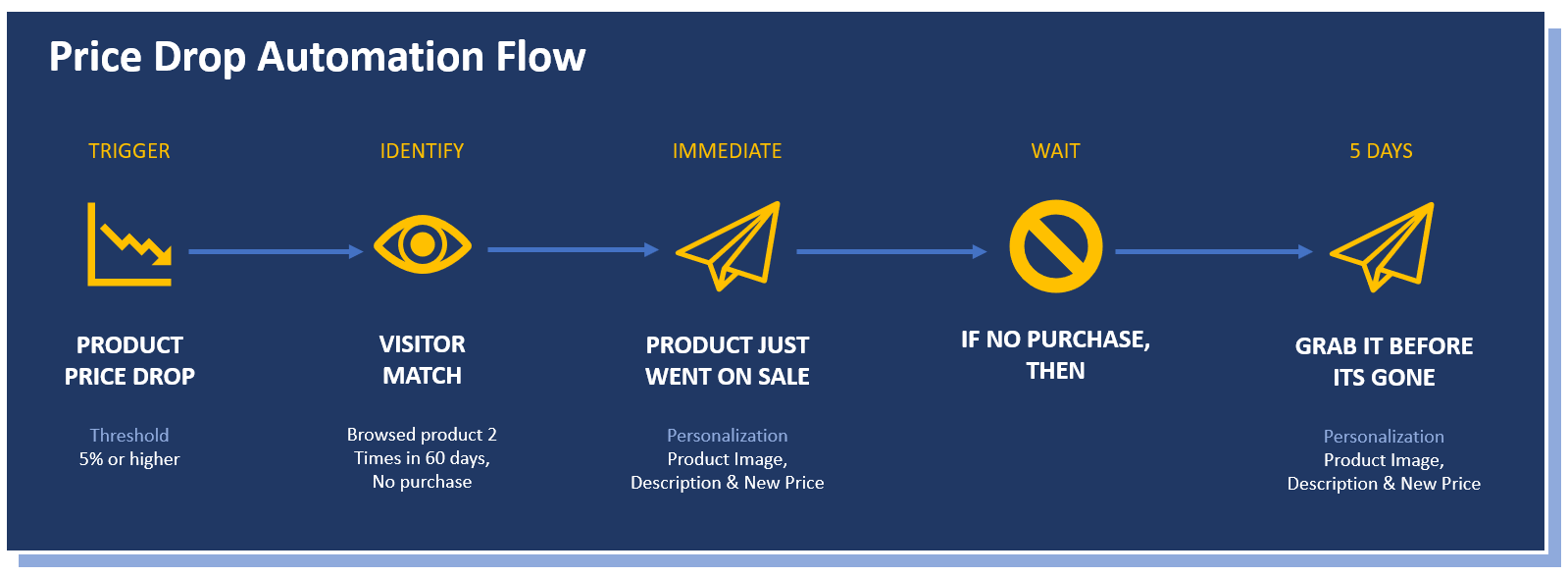
Price Drop Automation Flow
Fashion automation #3: Set up an Omnichannel Cart abandonment flow to increase recovery
For eCommerce shops, the average cart abandonment rate is as high as 70%. Setting up fashion automation for Omnichannel Cart abandonment is key to unlocking trillions of unspent dollars – as much as $4 trillion.
An omnichannel approach can help by utilizing push notifications. That’s because push notifications have an amazing Open Rate. Over 10% of abandoned cart recovery emails are clicked, and of those, 30% lead to a purchase back on site.
In fact, ContactPigeon is currently running a pilot for omnichannel cart abandonment flow to increase recovery with a fashion retailer and the results will be posted soon! Stay tuned…

Example of Fashion eCommerce marketing cart abandonment email
Suggested Set up: Try setting up various messages to interact with shoppers at timed intervals. For example, start off by setting up 2 emails + 2 push notifications. Use intervals of 4 hours, 24-hours, 3 days and 1 week after abandonment. This is a solid recipe with great results based on our data. You can also support the cart abandonment campaign with social media campaigns targeting the visitors with the cart items. Just remember to suppress any notification in case the customer has made a purchase in the meantime!
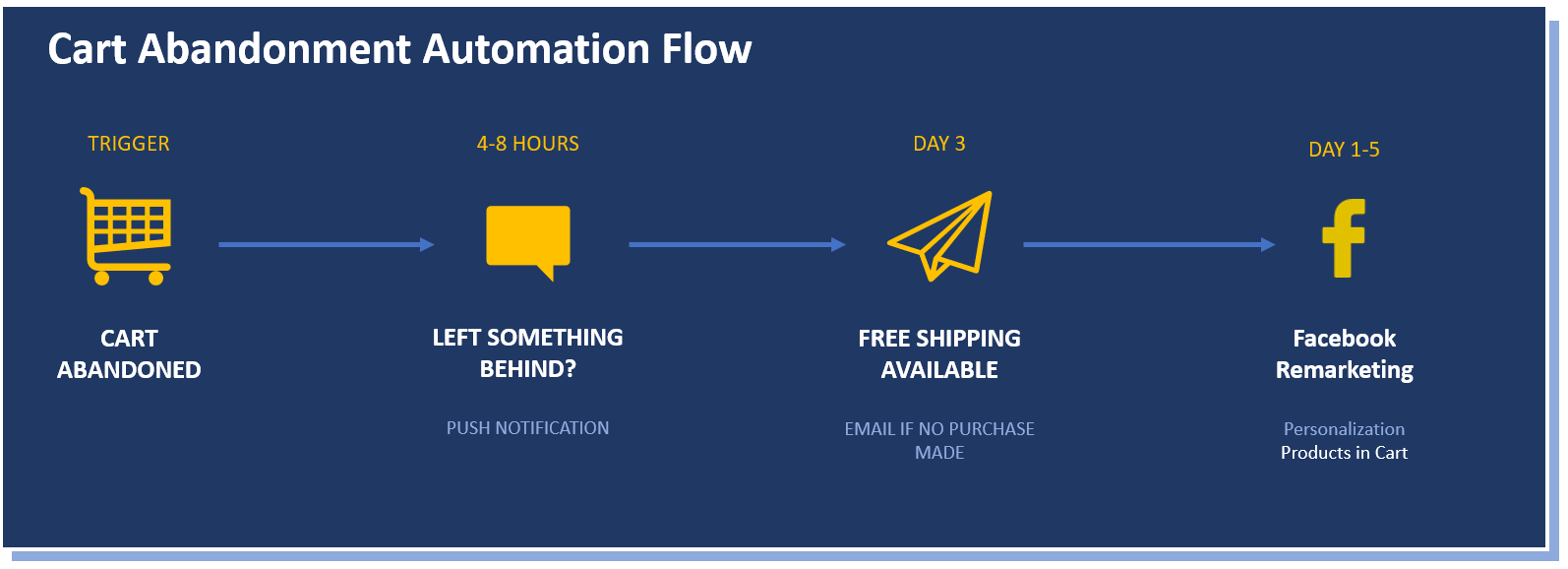
Simplified flow of abandoned cart automation across different channels.
Fashion automation #4: Order confirmation
Even transactional communications such as order confirmation can be an opportunity to grow customer satisfaction and upsell your products if they are well executed. The order confirmation aims to update customers on the status of their purchases. This helps establish brand trust. At the same time, messages can be used for on-target cross-sell recommendations and customer reviews.
Suggested Set up: Turn the standard transactional messages into opportunities to cross-sell compatible fashion items to those purchased, sign up for loyalty programs, or request for reviews. The flow below illustrates a simple way to incorporate the two types of information into a sequence of order confirmations.
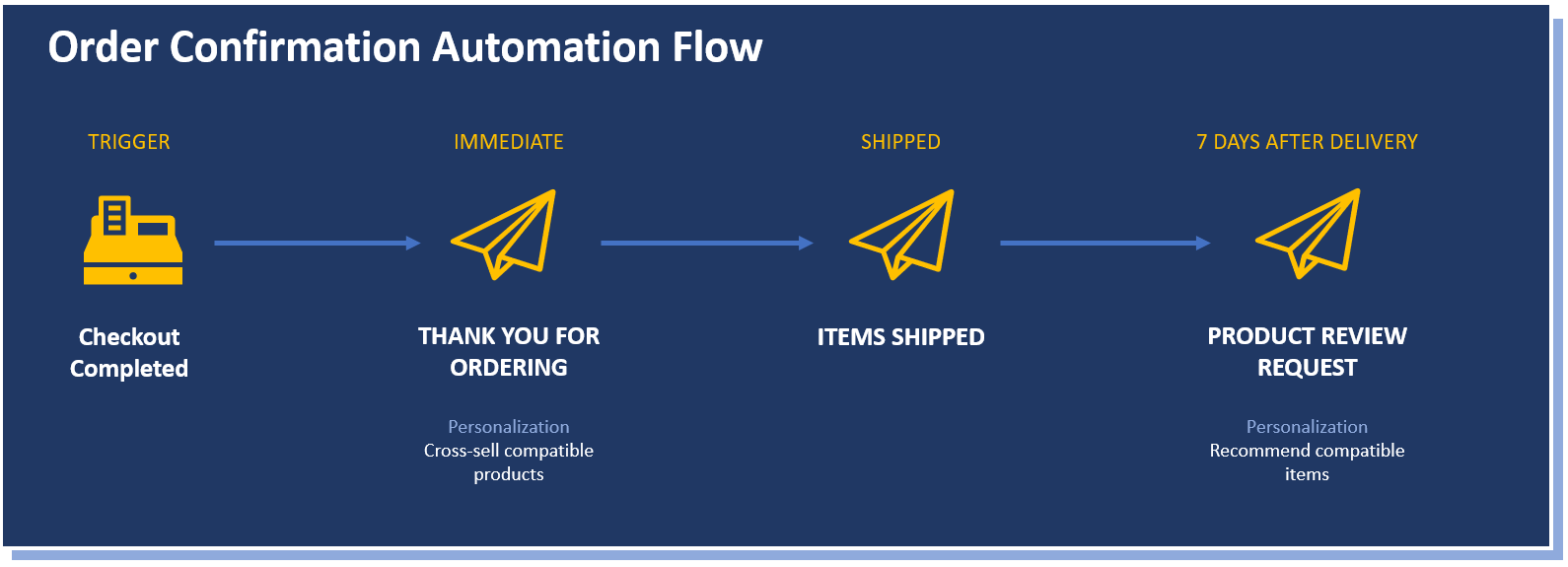
Sample Order confirmation automation flow
Fashion automation #5: Back in stock notifications
Sometimes, the supply in your inventory may not be readily available to meet demand. Instead of losing the sales, a way to recoup the opportunity is to capture visitor interest and alert customers once the product is back in stock. Hence, Back in stock notifications are a great way to keep shoppers engaged with your brand. It helps to track buyer interests and creates a more personalized shopping journey for each customer.
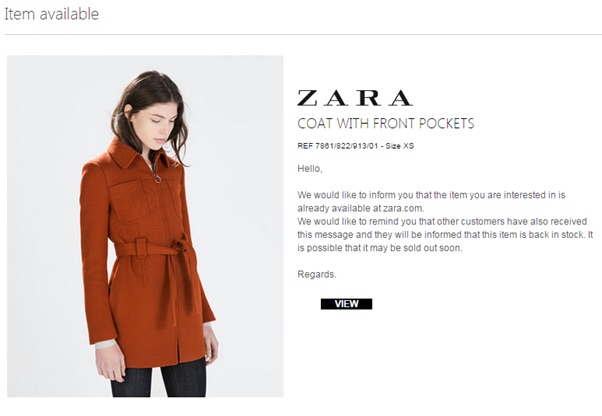
Zara uses automated marketing to let customers know when their items are in stock and available to purchase
Suggested Set up: The Back-in-Stock alert button on the product page is a common way to gather customer interest. It asks the visitor to enter a contact detail where the notification can be sent once the items are restocked.
Yet, did you know that Back-in-Stock can be used even without an alert button? Back-in-stock reminders can be sent to known visitors (those with contact detail) who recently browsed items that are out of stock using an automation flow. This way, once out of stock items are replenished, a triggered message is sent to customers who previously viewed them in either a push notification or email.
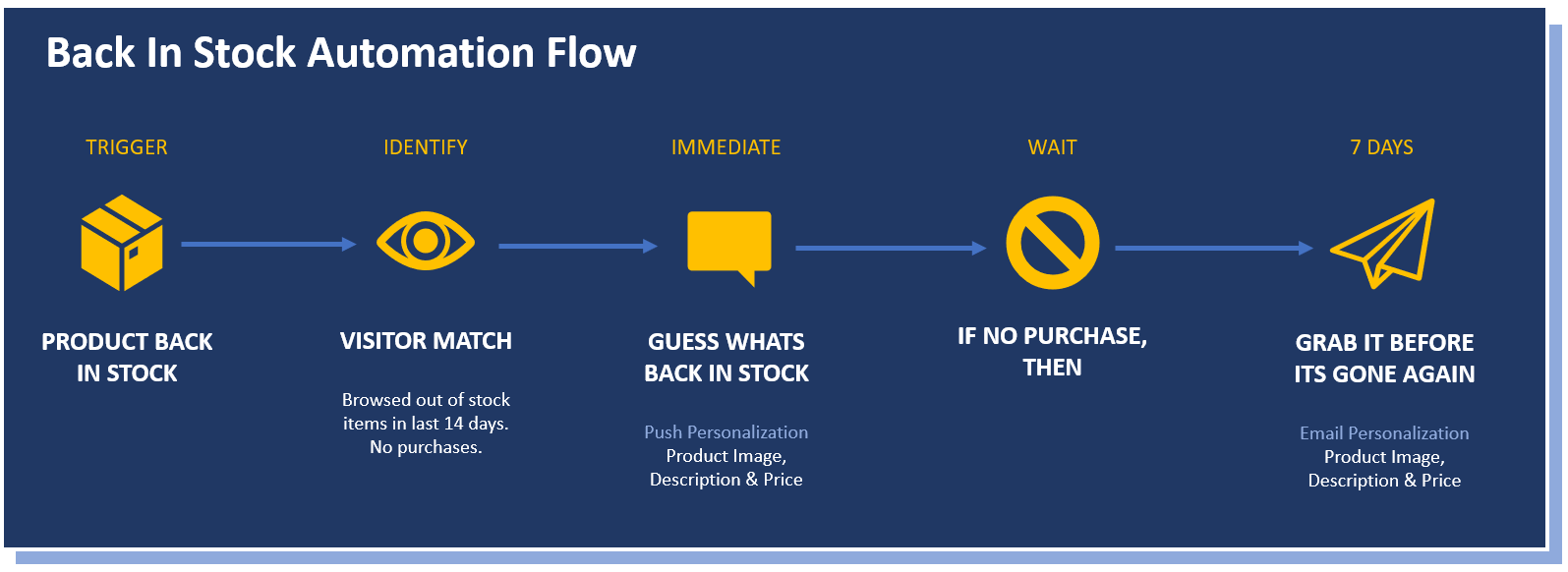
Sample Back-in-Stock Flow
3 excellent fashion eCommerce marketing examples that do it right
Example #1: Jigsaw
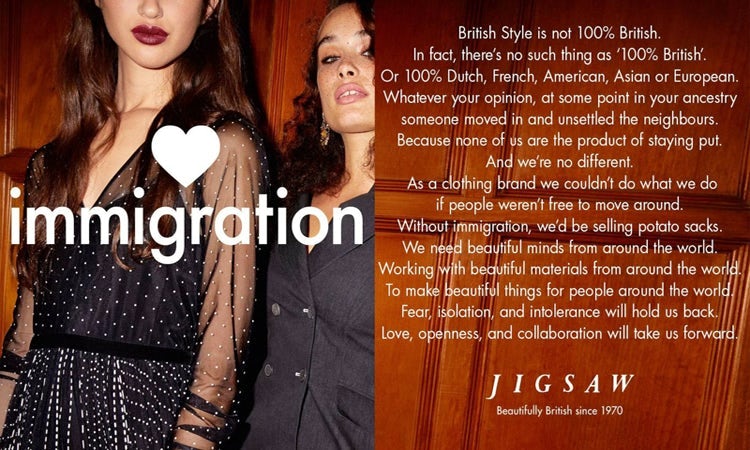
Jigsaw uses automated marketing in their Love Immigration fashion eCommerce marketing campaign
Company: Jigsaw. This British company is constantly raising the bar of excellence when it comes to their viral attention-grabbing marketing campaigns. In 2019, online sales at Jigsaw increased by 32 % over an 11 month period, while the site’s conversion rates are up 29%.
What we liked: Starting in 2017, Jigsaw set itself apart from the crowd by using a socially conscious automated fashion ecommerce marketing strategies. Their campaign, “Love Immigration”. The brand showed off its diversity with a print, social, and digital marketing campaign centering around the importance of immigration in fashion. The celebration of diversity within British fashion highlighted the brand’s core messaging.
Example #2: Ted Baker
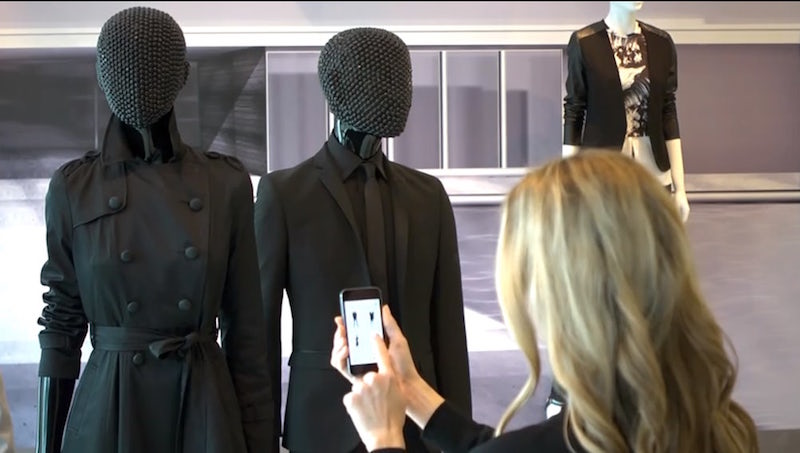
Ted Baker uses the latest technology in marketing automation for its fashion eCommerce marketing campaigns
Company: Ted Baker, a British luxury clothing retail company. In March 2019, the company reported gains in their eCommerce site with sales increasing 20.4% to £121.7 million, year-on-year.
What we liked: Ted Baker is always coming up with original marketing ideas — and one of their latest is communicating mannequins at their Westfield store. The mannequins create a seamless shopping experience for the brand’s customers, bridging the gap between off and online retail. By downloading a free app, shoppers receive a push notification when in a 50-meter range of a Ted Baker Bluetooth enabled mannequin! Then, the mannequin’s sends messages detailing clothes and accessories on display and offers shoppers the chance to purchase items directly from Ted Baker’s retail website and check out what is available in-store.
Example #3: ZARA
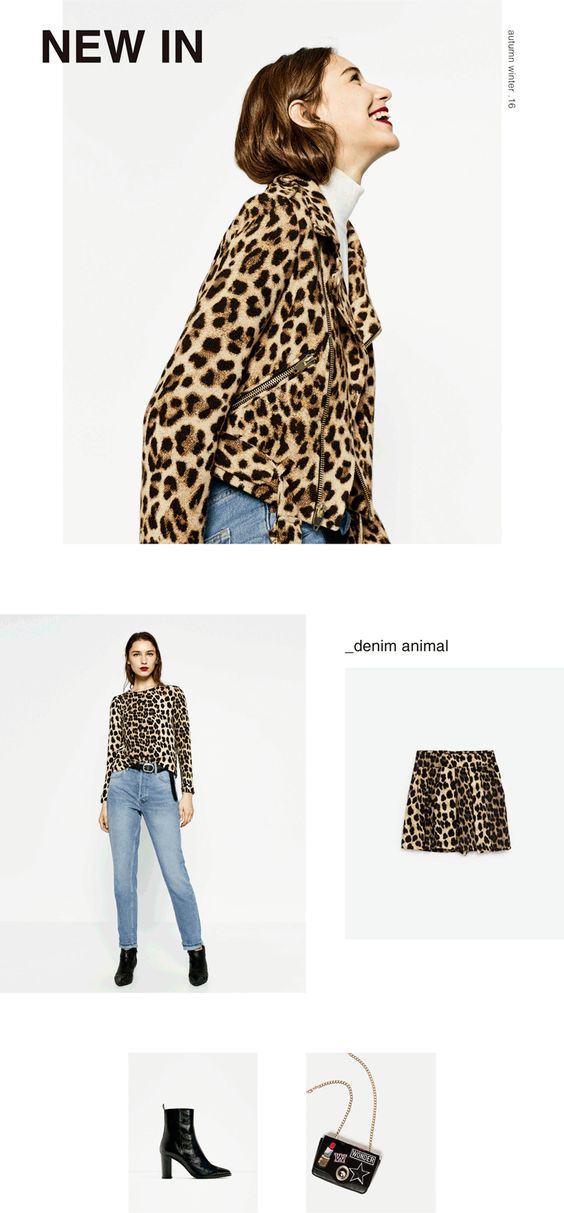
Zara uses automation to announce a new collection
Company: Zara. This company offers the latest fashion trends at the speed of light. No wonder that in 2017, Zara’s eCommerce revenue increased by 41% for the fiscal year.
What we liked: We love that Zara’s eCommerce strategy makes shoppers feel as if they have a personal shopper at their side. Zara uses an automated marketing platform for sending relevant and timely emails notification to shoppers regarding everything from order status updates to back in stock notifications, and so on. Throughout the entire customer journey, the brand keeps its messaging on-target and personal, catering to the shopping needs and web-behavior.
Hint: If you search for detailed fashion retail case studies take a look at our in-depth articles:
- Farfetch Case Study: Analyzing The Strategy of the UK Fashion Unicorn
- New Look: The Marketing Strategy Behind the UK Fast-Fashion Retailer
- How ZARA Dominates the Ecommerce Fashion Industry
Interesting Fashion eCommerce industry statistics
- Fashion Stat #1: According to Statistica, in 2018, apparel accounted for 65% of the fashion market, followed by footwear (25%) and bags and accessories (10%).
- Fashion Stat #2: The global online fashion market was worth $533 billion in 2018, and is predicted to grow to $872bn by 2023.
- Fashion Stat #3: Mobile accounts for 65.4% of traffic to online fashion retailers and 57.1% of sales.
- Fashion Stat #4: Internet Retailer says that 14.9% of US consumers say they never buy clothing online…
- Fashion Stat #5: 6.4% of shoppers say that they don’t buy in stores.
- Fashion Stat #6: The majority of shoppers under 34-years-old in both the US and the UK prefer to browse fashion sites using their smartphones.
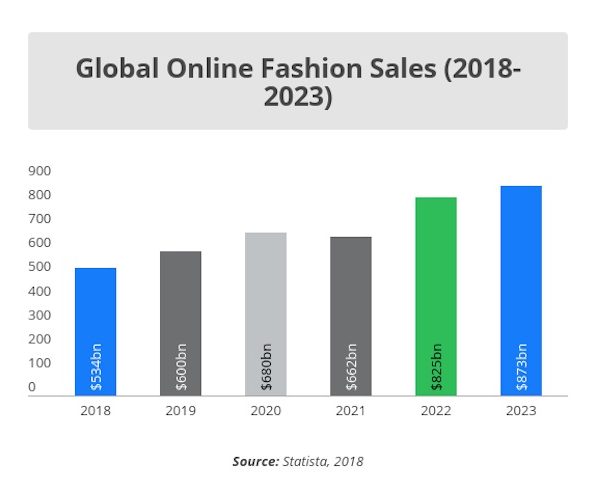
Conclusion: The executioner takes it all
There are no excuses for any brand in 2019 to not implement automation flows that actually work. Fashion is a global and an extremely competitive market. The only way to grow and prevail is via continuously hustle and evolution. Automating your processes is a must as competition is fierce and brand loyalty gets smashed year after year.
Don’t allow your fashion brand to struggle to find a way to stand out from the crowd and grow. You need to invest in a reliable, proven omnichannel marketing automation tool for fashion marketing in 2019. ContactPigeon already powers up global brands like Marks & Spencer by offering marketing automation fitting every marketer’s needs.


